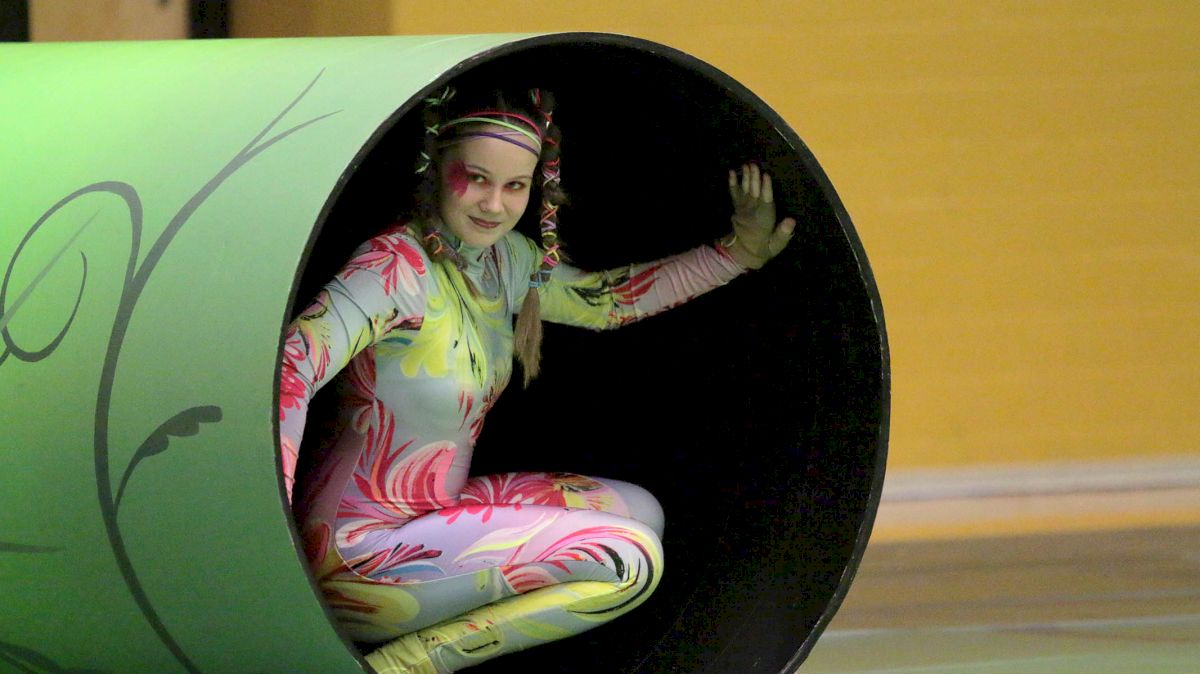Carmel 2018: 'Emerging' Breathy, Bold, And Beautiful
Carmel 2018: 'Emerging' Breathy, Bold, And Beautiful
From start to finish, Carmel's 2018 show "Emerging" brought together quirkiness, melancholy, and incredible color guard performance all-in-one.

Unlock this article, live events, and more with a subscription!
Already a subscriber? Log In
By Marcus J. Hopkins
Marcus J. Hopkins has been involved in the marching arts as a performer and instructor since 1985. He majored in Music Education at West Virginia University and was a performer with Dobyns-Bennett Scholastic World Indoor Drumline ('00), The Cadets Drum and Bugle Corps color guard ('01-'03), and Ad Astra Per Aspera Independent World Winter Guard ('05).
When I first listened to Carmel's 2018 winter guard show, "Emerging," I knew I’d heard its source music from somewhere before but couldn’t place it… until the very end of the performance.
As the pianist spoke the line, “What an ending; what an appalling ending,” my memory was jogged by Oscar Wilde’s exclamation in his letter to Lord Alfred Douglas, "De Profundis."
For those who’ve forgotten their Latin, "De Profundis" literally translates to “from the depths,” and Wilde’s letter to Douglas is, essentially, from the depths of his soul. (You can find the letter in its entirety here.)
While I could go into further detail on the content of Wilde’s letter, for the sake of brevity, I’ll say only this: The importance of the source material is relevant, in my view, because the program put forth by Carmel High School stands in stark opposition to both the letter and this glorious composition by American piano virtuoso Frederic Rzewski.
"De Profundis" (the piano work, rather than the letter) is a half-hour long performance by Rzewski in which he reads Wilde’s letter, replete with vocal sobs, exercises, and runs. Since the maximum show length for Scholastic World is 7 1/2 minutes, the Carmel designers were smart and cut it down—pause for laughter.
The source material is dark. It is literally a letter to Wilde’s former lover written from prison about their time together and the suffering he’s endured after being unjustly imprisoned for “gross indecency.”
Carmel’s take on the music, however, was diametrically opposed, focusing instead upon the levity present in Rzewski’s performance. The show was both playful and, at times, heartbreaking and haunting.
The title of the show, “Emerging,” in no small part refers to the performers moving out of and into four gigantic green pipes that move around the floor to both set the stage and serve as convenient places to “store” performers when they’re not needed.
Throughout the show, the performers were responding to Rzewski’s vocal cues—sighs, lip buzzing, yawns, sobs, vocal pops. Each was reflected in the choreography, whether that be the movement or equipment writing.
All of these young women were trained in the art of modern dance, and their responsiveness to the vocal cues was sublime. With the introduction of the rifle line, Carmel’s focus on weapon technique shined through the tossing tricks and into the work that built into each release.
Carmel's six-person flag line then introduced the first large block of color that isn’t “green,” with work that, again, was in response to the vocal cues more than the underlying piano melody.
As the work continues, there was a sense of playfulness to both the work and the performance qualities put forth by the performers. At one point, Rzewski hums the tune of “London Bridge is Falling Down”—the guard responded with a rifle soloist throwing a six while the rest of the guard is doing the dreaded “bridge” stretch that is the stuff of gym class nightmares. Both amusing and appropriate.
Once the bridges fall, they materialized into the sabre line, which comes out with a dark melody that lended itself well to some tricky work performed in a canon (the same phrase with different performers beginning at different times).
It was with the introduction of the dark flag that the heartbreaking moment of the show came together. The image on the flag was the negative of a man with green lines coming out of his mouth, and the lyrical work was being performed to Rzewski’s sighs. This ensemble feature was, by far, my favorite part of the show, because it showed the precision with which these performers execute their work together.
Without a steady beat to hold the group together—Rzewski's tempo marking throughout the piece is known as a "piacere" or "ad libitum" (at the performer’s discretion)—meaning that he would suddenly slow or speed up while playing. Responding to this, as a performer, required a great amount of skill.
As the show began to wind down, the performers started crawling into and out of the four giant green tubes, being dragged back into them, and eventually emerging to perform a well-choreographed, yet hilarious, dance block in the front left corner of the floor. I say “hilarious,” because the choreography responded fantastically to Rzewski’s literal barks, chicken squawks, and howls, ending with the guard marching in high step (like a dance band drum major) into the tubes while a sabre soloist catches her six on the very last note.
The ending, that sparked my memory as Rzewski mutters, “What an ending; what an appalling ending.”